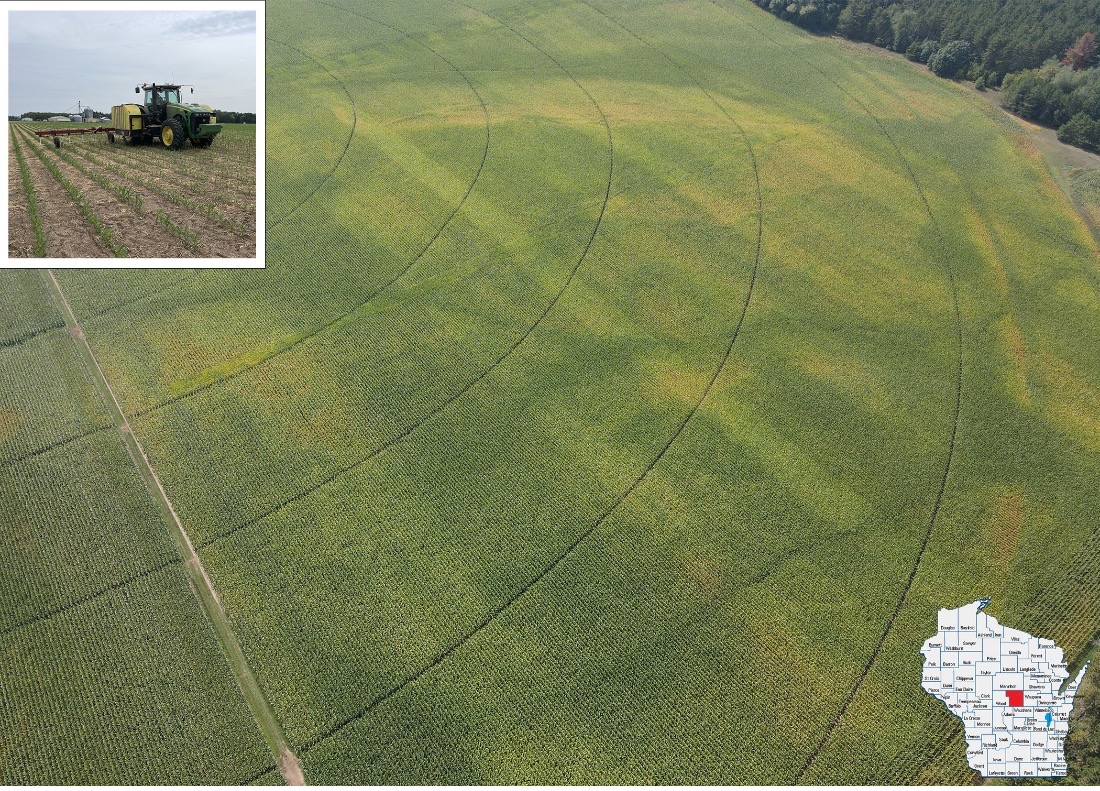The Commercial Nitrogen Optimization Pilot Program (NOPP) is a grant program funded by the State of Wisconsin, administered by the Wisconsin Department of Agriculture, Trade and Consumer Protection (DATCP), and supported by the University of Wisconsin–Madison Department of Soil Science and Division of Extension. These grants aim to refine and enhance the understanding of methods that optimize commercial nitrogen applied to agricultural fields, helping to protect vital soil and water resources. Read below to hear what Wisconsin farmers are investigating with their NOPP funding!
Turzinski
Nitrogen Optimization Pilot Program (NOPP) grantee, Ben Turzinski (with assistance from UW-Madison Extension Educator Ken Schroeder), created a project called “Field-Scale Corn Nitrogen Rate Study on Irrigated Loamy Sands”.
When asked why he applied for a NOPP grant, Ben pointed out that “the funding assistance made [on-farm research] more feasible because yield will take a hit and there are other financial risks involved.” Ben was interested in finding out if he’s using the appropriate nitrogen rate and he wanted to try different management strategies that impact N. “The results [of this study] will determine if I change what I do year to year on the fields” he says.
Other reasons Ben decided to plunge into on-farm N research were the technology and collaboration aspects: Executing trials with varying nitrogen rates “adds extra work but, with technology, now it can be mapped out ahead of time and adjusted right in the cab.” Ben is also collaborating with Ken Schroeder, Crops & Soils Extension Educator. As Ben puts it, “Ken has been really helpful with keeping everything in line!”

Lafayette Ag Stewardship Alliance (LASA)
Four farms affiliated with the Lafayette Ag Stewardship Alliance (LASA) are Nitrogen Optimization Pilot Program (NOPP) grant recipients. Their project is designed to explore the following question: “What is the optimum N rate that maximizes profitable corn grain production and limits the risk of N loss to environmental factors when planted green into cereal rye cover crop?”.
The group asserts that understanding the N cycle within a cover crop system is paramount to successful N management, noting that the N immobilization rate of cereal grain cover crops is expected to increase as the C:N ratio of cover crops increases.
Another motivating factor for pursuing NOPP funding is the opportunity to conduct local on-farm, field-scale research within the driftless region of Wisconsin. Due to a high risk of soil and nutrient runoff and nutrient leaching in this geography, this project will evaluate the N management requirements necessary to increase acres of cover cropping and no-till across the region. In addition, the ability for producers to conduct field-scale research on-farm offers increased validity and acceptance amongst growers compared to remote, small-plot research.

Blank
Brendon Blank is a 2023 Nitrogen Optimization Pilot Program grant recipient with a project titled “N rate for best Winter Triticale forage yield, quality, & phosphorous removal”. Partnering with 3 farms in Dodge County, Brendon is hoping to find answers to some of his questions:
“I see winter triticale as a growing interest in dairies and there has been a lot of success with it but, there have also been failures and disappointments, so we want to finetune what makes the system work best. From the nitrogen standpoint, the grasses are unique in the fact that, the more nitrogen you put on, the more you increase protein level of the crop. This makes it more difficult to determine the economic plateau – it’s a more dynamic system with more work to figure out where the plateau is. Can we fertilize beyond our yield plateau economically? Is it more economical to fertilize to yield or quality?
I also think about the nutrient management aspect of it from a manure standpoint – can we pull more phosphorus out of the system? From a soil health standpoint, it can be beneficial in the long-term, but [adding a crop] results in a new management system with different timings. If we give up corn silage yield [to accommodate triticale planting], are we getting something back in triticale yield?”





